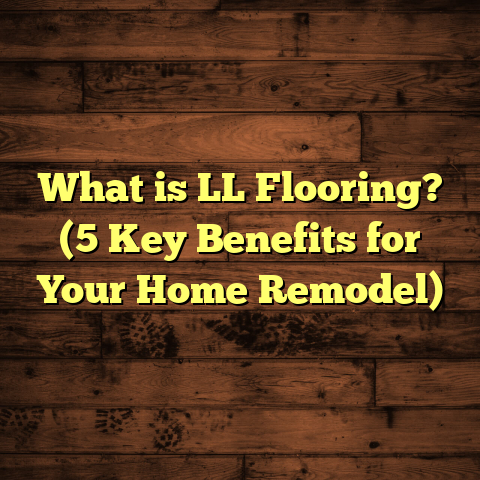What is a Tiled Floor? (5 Essential Benefits for Your Home)
Craftsmanship is something I’ve come to deeply respect over my years working with flooring. It’s the careful, precise, and patient process of turning raw materials into something both functional and beautiful. When I first laid my hands on tiles decades ago, I was fascinated by how such small pieces could come together to form a stunning surface that lasts for decades. The beauty of tiled floors is not only in their appearance but also in the skill and dedication behind every installation. That craftsmanship is what makes tiled floors a lasting feature in countless homes.
I want to share everything I’ve learned about tiled floors—the benefits, the challenges, and some stories from my own work. By the end, you’ll understand why so many homeowners choose tiles and how they can fit into your space perfectly.
What is a Tiled Floor?
Let’s start with the basics: what exactly is a tiled floor? At its core, a tiled floor is a flooring system made up of individual flat pieces called tiles. These tiles are usually made from materials like ceramic, porcelain, natural stone (such as marble or slate), glass, or even metal. The tiles are set onto a base or subfloor with adhesives or mortar and then grouted to fill the gaps between them.
These individual tiles are designed to be durable, water-resistant, and often decorative. They come in all shapes and sizes—from small mosaic squares to large slabs—each serving different aesthetic and practical purposes.
When I explain this to clients, I often compare it to a puzzle, but one where every piece must fit precisely. One misplaced tile can throw off the whole pattern or create unevenness that you’ll feel underfoot.
Materials Commonly Used for Tiles
- Ceramic: Made from clay and hardened by heat, ceramic tiles are popular for their affordability and variety. They typically have a glazed surface that adds color and sheen.
- Porcelain: A denser, more durable form of ceramic tile that absorbs less water. Porcelain is great for high-traffic or wet areas and has a more refined finish.
- Natural Stone: Marble, granite, slate, and travertine fall into this category. Each stone type brings unique patterns and textures but requires some extra care.
- Glass: Mostly used in decorative accents or backsplashes; glass tiles add brightness and reflections.
- Metal: Less common but used in modern designs for accents or borders.
How Tiles Are Installed
The installation process is where craftsmanship truly shines. It involves:
- Preparing the Subfloor: This means ensuring the surface beneath is smooth, level, and clean. Any bumps or dips can cause cracking later.
- Laying Down Adhesive: Using thinset mortar or tile adhesive to attach each tile securely.
- Positioning Tiles: Carefully placing each tile according to the design pattern.
- Grouting: Filling spaces between tiles with grout to lock them in place and prevent dirt from getting underneath.
- Sealing (Optional): Especially necessary with natural stone tiles to prevent staining.
Why Tiles?
Why do so many people choose tiled floors? The answer lies in their combination of durability, style options, and functionality. Over time, I’ve worked in environments ranging from cozy homes to commercial kitchens where heavy foot traffic demands resilient flooring.
Successes and Challenges: My Journey with Tiled Floors
Every flooring project tells a story—some smooth and rewarding, others full of unexpected problems that tested my skills.
Success Stories
One project that stands out was a client’s bathroom renovation in a coastal home. They wanted something that could withstand humidity and occasional saltwater exposure while looking fresh and modern. We chose porcelain tiles with a matte finish that mimic natural stone.
The floor installation went smoothly thanks to thorough prep work. The result? A floor that still looks flawless five years later despite regular exposure to moisture and sand from beachgoers. This project reaffirmed my belief that with the right materials and care, tiled floors can last a lifetime.
Another success was an open-plan kitchen-living area where we used patterned encaustic-style tiles to create a vintage feel. The client loved how these tiles set the mood without overwhelming the space—a fantastic example of how tile design can elevate interior aesthetics.
Challenges and Lessons Learned
Not every job has been easy though. Early in my career, I installed ceramic tiles on an old concrete subfloor without proper leveling. Weeks later, several tiles cracked under normal use.
This costly mistake taught me an invaluable lesson about the importance of subfloor preparation—something I stress to clients now before any tiling begins.
Grout maintenance has also been a recurring challenge. Grout can discolor or crack over time if exposed to moisture or dirt without proper sealing. I’ve had to return to projects years after installation to clean or replace grout—a reminder that maintenance is part of owning tiled floors.
Five Essential Benefits of Tiled Floors for Your Home
Now let’s dig into five key benefits that make tiled floors an excellent choice for many homeowners—including myself during my own renovations.
1. Durability That Stands Up to Life
Tiles are some of the toughest flooring materials available. Whether ceramic, porcelain, or stone, they resist everyday wear remarkably well.
In one case, I installed porcelain tiles in a busy restaurant kitchen where spills and foot traffic were constant. After several years, the floor showed minimal signs of wear—no chips or cracks—proving its resilience.
The Mohs hardness scale rates porcelain tiles between 7-8, meaning they’re harder than steel in some cases! This makes them ideal for homes with pets or kids who tend to be rough on floors.
Data Point: According to industry research, porcelain tiles have an average lifespan of 25-30 years with proper care—double that of hardwood flooring.
2. Easy Maintenance—Less Time Cleaning, More Time Living
Nobody likes spending hours scrubbing floors after a long day. One reason clients tell me they switch to tiles is for how easy they are to maintain.
Tiles resist stains and spills better than carpets or wood thanks to their non-porous surfaces (especially porcelain). A quick sweep followed by mopping with mild detergent often does the trick.
In my own kitchen, I’ve spilled wine, tomato sauce, and oil numerous times—and never had a stain stick around after cleaning.
Did you know? Porcelain tiles absorb less than 0.5% moisture compared to 3-7% for standard ceramics—making them even easier to clean.
3. Style Options That Fit Every Taste
One of the most exciting parts about tiled floors is the endless variety of styles available. I’ve worked on projects using classic subway tiles in kitchens, intricate mosaic patterns in bathrooms, rustic terracotta in sunrooms—the list goes on.
Tiles allow you to customize your space in ways few other flooring materials can match.
For example:
- Color: Tiles come in every shade imaginable.
- Pattern: From simple grids to herringbone or chevron.
- Texture: Matte, glossy, rough stone-like finishes.
- Shape: Squares, rectangles, hexagons, even custom shapes.
A client once said their tile choice reflected their personality more than any furniture or paint color ever could!
4. Hypoallergenic Flooring for Healthier Homes
If allergies run in your family like mine, you understand how important indoor air quality is.
Carpets often trap dust mites, pet dander, and other allergens that circulate when disturbed by movement.
Tiled floors don’t harbor these allergens as much because they’re hard surfaces that don’t absorb particles.
Research shows homes with hard flooring like tile tend to have fewer airborne allergens compared to carpeted ones—a big plus if anyone suffers from asthma or allergies.
Personal Insight: A client with severe allergies switched from carpet to tile throughout their home and noticed a significant drop in allergy flare-ups within months.
5. Adding Value That Pays Off Later
Installing tiled floors can be an investment in your home’s value too. Many buyers appreciate seeing durable floors that require less upkeep and look great.
According to real estate studies:
- Homes with tiled kitchens and bathrooms tend to sell faster.
- Properties with natural stone or porcelain tile floors can command higher prices.
One homeowner I worked with saw their property value increase by nearly 8% after adding high-end tiled floors in key areas like the entryway and kitchen.
Diving Deeper: Detailed Insights & Case Studies
Beyond these benefits lie fascinating details about how different tile types perform in real-world conditions—knowledge I’ve gained through years of hands-on experience combined with industry data.
Porcelain vs Ceramic: What’s the Difference?
Many people ask me whether they should choose ceramic or porcelain tiles. Here’s what I usually say:
| Feature | Ceramic | Porcelain |
|---|---|---|
| Water Absorption | 3-7% | <0.5% |
| Durability | Good | Very High |
| Price Range | $1-$5 per sq ft | $3-$10 per sq ft |
| Suitable For | Low to medium traffic | High traffic & wet areas |
| Installation | Easier | Requires precision |
For bathrooms or outdoor patios where moisture is high, porcelain wins hands down due to its low porosity.
In one recent case study from a hotel renovation project I helped with:
- Ceramic tiles cracked within 2 years due to heavy foot traffic outdoors
- Porcelain tiles installed inside lobbies showed no damage after 5 years
Natural Stone Tiles: Beauty Meets Responsibility
Natural stone offers unmatched beauty but comes with maintenance requirements. Marble needs sealing annually; slate can chip if walked on heavily without protection.
I once installed slate flooring in a mountain cabin where owners loved the rustic look but found it challenging during winter months when salt used on walkways caused stain marks on unsealed stone.
The lesson? Stone needs care but rewards you with timeless elegance once maintained properly.
Common Problems & How I Fix Them
Even with my experience, tiled floors can present hurdles:
Cracked Tiles
Causes: Poor subfloor prep, heavy impacts
Solution: Always level base before installation; use flexible adhesives where movement may occur
Grout Issues
Causes: Discoloration from dirt/moisture; cracking due to shrinkage
Solution: Seal grout lines after installation; clean regularly; replace grout if damaged
Loose Tiles
Causes: Adhesive failure; moisture behind tile
Solution: Use recommended adhesives; check moisture levels before laying tile; allow curing time properly
Cold Floor Feeling
Tiles naturally feel cool underfoot—great in warmer climates but less so during winter.
Solution: Underfloor heating systems can warm tiles effectively; area rugs help add comfort too
Slippery Surfaces
Glossy tiles may become hazardous when wet.
Solution: Use textured or matte finish tiles for bathrooms/entryways; consider anti-slip coatings if needed
My Personal Flooring Stories: Real Life Examples
I remember helping a family who wanted tile throughout their entire home—including bedrooms—which is uncommon but fascinating!
They wanted durability for their energetic children combined with style that felt cozy rather than cold.
We chose warm-tone ceramic tiles with soft matte finishes paired with thick area rugs for bedrooms.
They reported loving the look plus how easy cleaning was after messy playtimes!
Another story is about a client who was hesitant about tile because “it feels hard” on feet.
We installed radiant heating beneath porcelain tiles in their bathroom and kitchen so floors stayed warm year-round—they were amazed by how comfortable it felt afterward.
Data You Can Trust: Flooring Longevity & Costs
Here’s what data and industry reports say about tiled floors compared to other options:
| Flooring Type | Average Lifespan (Years) | Average Cost per Sq Ft (Material + Installation) | Maintenance Level |
|---|---|---|---|
| Porcelain Tile | 25-50 | $8-$15 | Low |
| Ceramic Tile | 20-40 | $5-$12 | Low |
| Hardwood | 15-30 | $8-$20 | Medium (refinishing) |
| Carpet | 5-10 | $3-$7 | High (cleaning/replacement) |
From this data alone, it’s clear why many homeowners find tiled floors cost-effective over time despite higher initial investment compared to carpet or vinyl.
Final Words: Is Tiled Flooring Right for You?
Choosing flooring isn’t just about looks; it’s about lifestyle too. If you want durability mixed with style, easy upkeep combined with allergy-friendly qualities, tiled floors check almost every box.
Ask yourself:
- How much foot traffic does this area get?
- Is moisture exposure an issue?
- What kind of maintenance am I prepared for?
- Do I want design flexibility?
If you answered yes to most questions favoring durability and low upkeep, tiled flooring will likely serve you well.
If you want help choosing tile types or tackling tricky installation spots like uneven floors or radiant heating integration—I’m here to share more insights anytime!
Tiled floors aren’t just surfaces beneath your feet—they’re investments woven into your home’s story through craftsmanship and care. And from what I’ve seen throughout my career, they’re well worth it.





